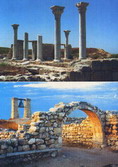
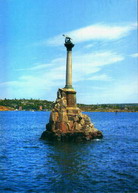
In 2003 the Hero City of Sevastopol celebrated another significant date: 220years of its foundation. The name "Sevastopol"' means "'the city of glory"' or "'the city worthy of worship"' in Greek. By a Decree of Russian Empress Catherine the Great dated August 13,1783, the city was designated a naval base of the Russian State. It has always been at the crossroads of Russian, Turkish, and Western strategic military interests. The unprecedented courage shown by the defenders of Sevastopol during the Crimean and Second World wars has won the city its unfading world-wide fame. The history of Sevastopol, abundant in remarkable events, lives on in the city monuments, names of squares, streets, embankments...
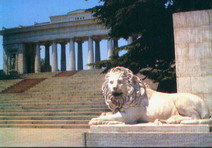
Grafskaya (Count's) Wharf.
This is a parade landing-stage, a city landmark and an architectural monument. It was among the first buildings of Sevastopol and initially was just an ordinary boat jetty.
In 1787, on the eve of the arrival of Catherine the Great, a wide stone staircase was built. To mark the Empress's arrival, the staircase was named after her. However, this name did not stick, just like 'III Internationale', the other pre-WW2 version. Only the name of Grafskaya Wharf has become firmly established, which is traced to Count Voynovich who commanded the Black Sea Fleet in the 1840s. The wharf acquired its present form only in 1846. Four marble statues were installed in the portico niches (only two of them have survived). Two marble lions designed by Ferdinando Pelliccio, an Italian sculptor, stand at the foot of the staircase.
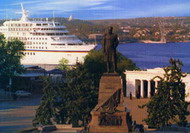
Monument to Admiral Nakhimov.
A monument to Admiral P. Nakhimov towers above the square bearing his name. It was designed by N. Tomskiy, a famous sculptor and A. Arifyev, an architect, and inaugurated in 1959. This is a second monument dedicated to a famous naval commander. The first one, erected at the same spot in 1898, in 1928 was demolished as a monument to "a czarist Admiral" with a Lenin statue replacing it which, in its turn, was taken down in the times of the Nazi occupation.
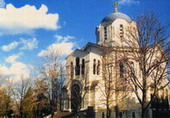
St Vladimir Cathedral - the crypt of glorious Admirals M. Lazarev, V. Kornilov, V. Istomin, and P.Nakhimov.
Located on the central hill of the city, its foundations were laid in 1854 on the eve of the Crimean War, in the course of which it turned into a monument to the heroes of the first Sevastopol defence. In the lower church Admirals Kornilov, Istomin, Nakhimov killed on the bastions of Sevastopol are buried. After the war the construction of the cathedral resumed, and it was consecrated in 1888. Before 1920 nine more senior officers of the Russian Navy were buried there. In 1932 the cathedral was closed and later was used for workshops and warehouses. The building suffered heavy damage during WW2. Since 1965 the cathedral has been under restoration, while in 1991 church services resumed there. The naval cathedral and monument continues to live and serve the people.
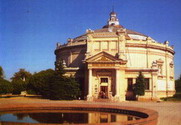
Historical Boulevard Panorama
In thecentral part of Historical Boulevard there is a building of Panorama "Defence of Sevastopol. 1854-1855" the unique work of battle painting. The painter Franz Roubant gave a memorable description of a battletaking placeon 6th (18) of June, 1855. The enemy bombed the city and stormed the bastions. But the defenders of Sevastopol held out.
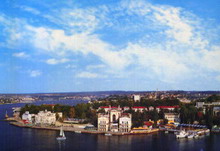
A view over the downtown Sevastopol from the Artillery Bay.
The downtown Sevastopol is washed by the waters of several bays, while in and around Sevastopol there are more than 30 bays giving the city its unique and inimitable colour. Primorskiy Boulevard, the famous Sevastopol Aquarium, and the Palace of Children and Youth are situated on the right side of the Artillery Bay...
Chersonesus is one of the most remarkable historical monuments in our country.
The excavations showed the ancient city to the whole world. During two thousand years (Vc. B.C.-XVc. AD.) the city was the large economical, cultural and political centre of the Northern Prichernomorye. Its century-old history was constantly interlacing with the history of different tribes and people, who lived in the south of modern Ukraine. These people were: Tavres. Skythans. Sarmats and others. The history of Chersonesus was mixed with the history of ancient (ireek cities and Rome Empire. Chersonesus was closely connected with Kievskaya Russ (IX-Xc.c.). First Tatars appeared in the Crimea in 1223. Then lurks, who had settled in Asia Minor, invaded the southern coast of the Crimea. Such events influenced the life of Chersonesus terribly. At the end of XIII с the army of the gold-horde commander Nogay captured Chersonesus. In the middle of XlVc. people from (ienoa began to control the city. Long ago they had had their military-strategical and commercial interests in the Crimea. The citizens of Chersonesus tried to survive in such conditions. But Tatars destroyed the city once again in 1399. Separate districts of the city continued their existence, but in the middle of X Vc. The citizens left them forever. The life was not renewed after that. The majestic name of the city was forgotten for some time.
The new life of Chersonesus-Cherson-Korsun began in 1S27. when there were the first archeological excavations, which continue even nowadays but with short pauses. Due to selfless labour of our native archeologists and historians we have the opportunity to know the history and culture of this unique centre of human
View of the Foggy Bell.
Above the precipice at the seacoast a copper bell is suspended between two massive stone pylons. On the rim of this bell there is an inscription, which is not at all distinct: "This bell was moulded... St. Nicholas Thaumaturge from Turkish artillery weighing 351 poods in August 1778..." By the beginning of the Crimean War (1854-1856) it was in Sevastopol. In August 1855 Sevastopol garisson retreated to the Severnaya Storona ("the Northern Side"). The Foggy Bell as well as 13 other bells from Sevastopol churches was taken to France as captured material. In 1913 the Foggy Bell came back to Sevastopol. Up to the beginning of 1960-s it was warning the ships about rocks and banks when it was foggy.
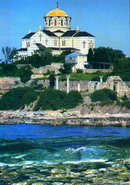
St. Vladimir's Cathedral (2-nd half of XX c).
The cathedral was built on the ruins of a middle-aged church. It became the temple-monument of Grand Duke Vladimir's christening in Chersonesus. The process of building this cathedral was timed to 900th anniversary of Russ christening. The academician Grimm D.I. was the author of St.Vladimir's Cathedral's design. August 23, 1861 F.mperor Alexander II and impress Maria Alexandrovna laid the first stone of the new cathedral. The cathedral was erected in the main square of ancient Chersonesus after 30 years of building. It was 26 meters high. The beauty and grandeur of the erected cathedral stroke everybody. It was crowned with huge dome with zinc tile and a big gold cross. The temple had 2 storeys and 5 sectors. In 1924 the temple was closed. It was destroyed during the Great Patriotic War. Divine service began from 1992. Today the temple is reconstructed.

Terracotta statue of an actor in tragic mask (IV-III c.c. B.C.). Ruins of the Antique Theatre (III с B.C.) and Christian Temple (VI с. В.С.)
Chersonesus antique theatre was built in III с B.C. The rows of benches were built on a steep slope of the gully. Earlier there was an ancient defensive wail of Chersonesus along the edge of the gully. Theatre performances usually lasted from the morning up to the evening, some times even for several days. From both sides the rows of benches surrounded the place where the chorus was situated. Near the edge of this place there was a public stone credence altar where during the performances and celebrations a fragrant mixture was burnt. This mixture-incense consisted of laurel, cinnamon, cones of Italian pine and different oils.About three thousand people could visit the theatre at once (1/3 of the whole population). Actors, musicians, poets acted on the stage. Chersonesus historian Sirisk, the son of Heraklidus, read his works there. In II-IIIc.c. the square for theatre chorus was rebuilt into the arena for gladiators' fights. After IV с A.D. when the Christianity-winner rejected heathen performances, the buildings and constructions connected with them were destroyed. In VI century on the territory of the theatre a temple (so-called "the temple with an ark") was built. During the excavations a silver relic with relic of saint unknown body covered by silk were found under the throne. The relic was given to St. Vladimir's Cathedral and the silver relic in the form of an ark was made in IV c. in Constantinople.
'Temple with an ark" was destroyed by the fire during the raid of Khan Edigey.
The independent Crimean khanate took its shape in the first part оf thе 15th century with the ascension to throne оf Hajji Geray Khan, a descendant of Genghisides, called the 'melek' (angel) by the people for his beauty. Legends say that the founder of the Crimean Khanate added the title of 'Geray' (or'Girey') to his name as a sign of gratitude to his mentor called Geray.
Solkhat (the present-day Staryi Krym) was the administrative centre of the Khanate initially, but soon Hajji Geray moved his headquarters to a well-protected fortress of Kyrk Yer. now known as C'hufut Kaleh. Summer and winter palaces, mint, mosque and religious school appear at this time inside the fortress and at its foot. Ashlama Sarai. the palace of the first Crimean Khan, was known to have existed back in 1704, although not a single stone of it has survived.
| Chufut-Kale | |||
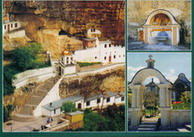 |
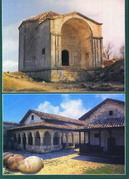 |
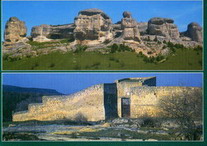 |
|
| Monastery of Assumption | Janikeh Khanym mausoleum. Karaite Kenasas | Valley of Sphinxes. Biyuk Kapu gates | |
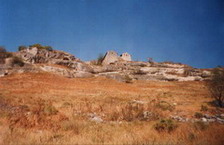 |
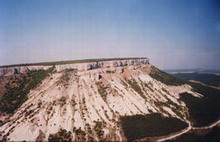 |
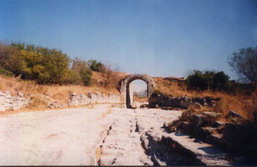 |
|
Early in the 16th century, when political situation in the peninsula became relatively stable. Hajji Geray's successors erected a new Khan's Palace which became a landmark and a hub of a future capital. The city received its name from the rich gardens ('bakhchy sarai') that formed an integral part of the Palace complex.
The Khan's Palace obviously does not fit into the European concept of monumental and well-ordered 'medieval' castles. As aptly pointed by Academician Pallas, it looks more like a free assemblage of lightweight structures implementing the elements of rococo and classical
Ottoman styles, whose architecture organically blends various European and Oriental motifs. Here the tendency to stress the grandeur of
power never becomes dominating; on the contrary, the air of ease and intimacy is prevalent
When visiting the Khan's Palace one should be aware that in its present state it is a far cry from its original appearance. In 1736 the Palace was burned down during Field Marshal Minich's campaign in the Crimea. Between 1784-87 Khan Sarai was rebuilt and renovated to
accommodate Empress Catherine II. More reconstructions followed in 1818. 1823. 1837, 1857. and 1861. distorting the original look of the
Palace. While certain architectural fragments and pieces of the Palace have survived to this day. the former glory and splendour of interior
decorations have almost perished, since the Palace was continuously pillaged in the late 18th century, when the Crimean Khanate was on the decline. Shagin Geray. the last Crimean Khan, moved the valuables remaining in the Palace to Turkey altogether.
Specific principles and traditions of Muslim art should also be taken into consideration when visiting the Palace. For example, painting and
sculpture failed to develop due to censure expressed by Muslims on portrayal of human beings and animals. On the other hand, ornamental design (especially floral patterns) and Garden of Paradise motifs in the architecture were brought to perfection. Besides, the Khan's Palace is a typical example of'hidden' architecture, where external inexpressiveness contrasts with interior grandeur, intensifying the perception of beauty.
In 1961-64 a scientific restoration of the Palace was undertaken by Kyiv-based science and restoration shops. A number of architectural
fragments and wall-paintings in Khan Sarai were recovered providing a better understanding of the original appearance of this medieval
masterpiece.
| Bakhchysarai | |||
 |
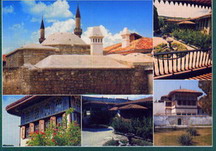 |
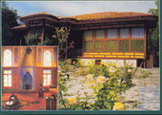 |
|
| Khan Jami: the larger mosque | Bath-houses. Views of the palace | Harem | |
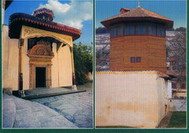 |
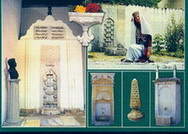 |
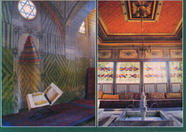 |
|
| Alevise portal.Falcon tower. | Fountains of the Khan's palace | The smaller palace mosque. Bower | |
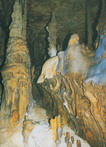
The Mramornaya Cave is located at the plateau of the Chatyrdag massif. The picturesque outline of this mountain seen from different points and distances is the symbol of the Crimea.
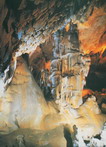
The Chatyrdag plateau is speckled with numerous karst cavities creating the "Moon surface effect". Over 160 karst caves, shafts and pits of the area are under conservation. The most interesting among them is Mramomaya Cave discovered in 1987. The entrance to it is located at 920 m above sea level. It lies in a block of Upper-Jurassic lime-stoneand consists of three parts: Main Gallery, Lower Gallery and lateral Tiger Passage. The huge galleries break into separate "halls". The passages that have been prospected are 2,050 m long and 60 m deep. The specially developped guided tour routes extend for over 1 km.
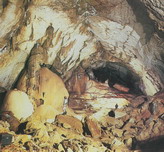
The uniqueness of the Mramornaya Cave made it world famous. According to the most famous speleologists, it is listed among the five most beautiful caves of the world open for visitors. In 1992 Mramornaya was admitted to the International Association of Equipped Caves (Ghenga, Italy) as one of the most frequently visited caves of Europe.
The Mramornaya Cave speleocomplex comprises the magnificent equipped cave Emine-Bair-Khosar and unequipped legendary caves Tysyachegolovaya (A Thousand-Headed one), Kholodnaya (Cold) and Tryokh-glazka (A Three-Eyed one). They are all located at a 15-minute walking distance from a bus stop.
List of the literature